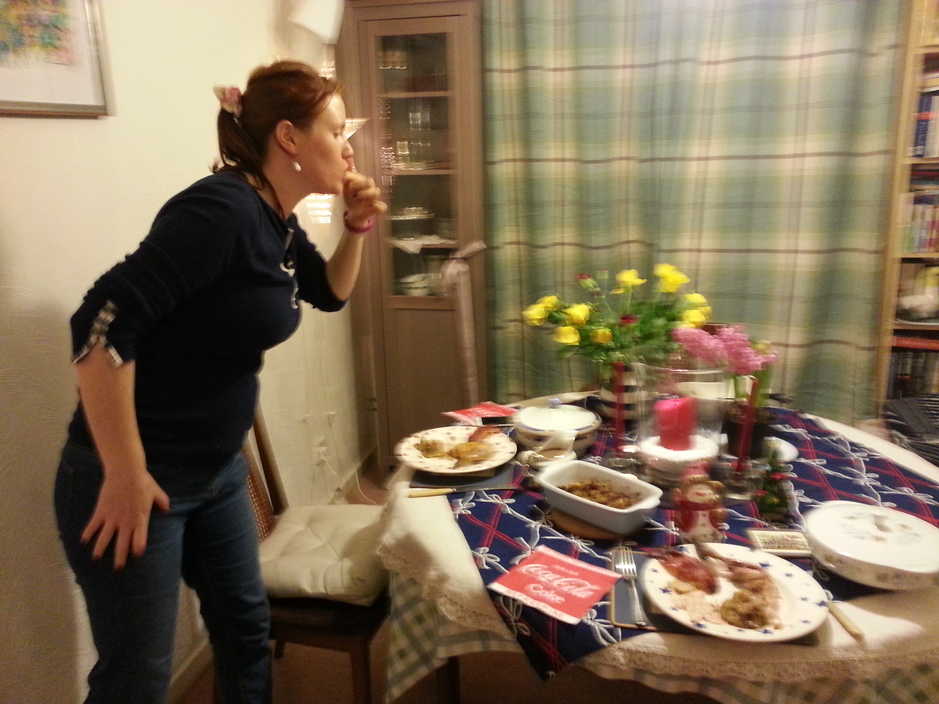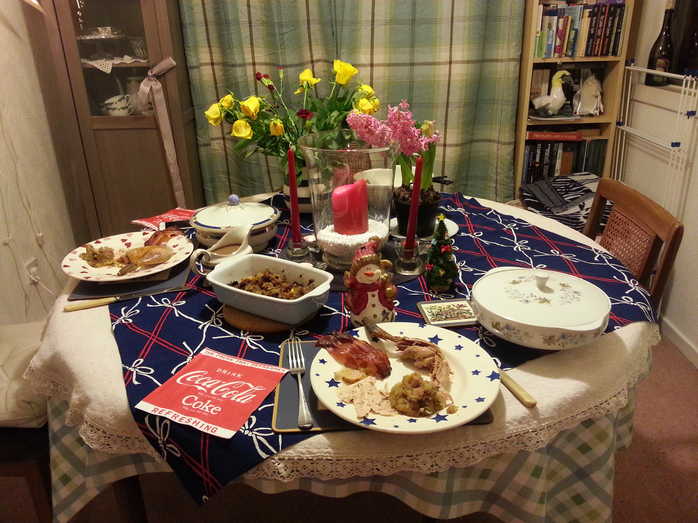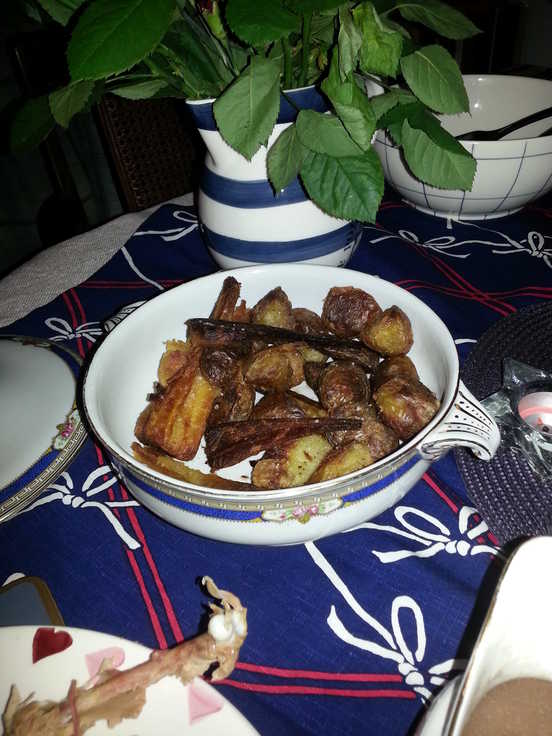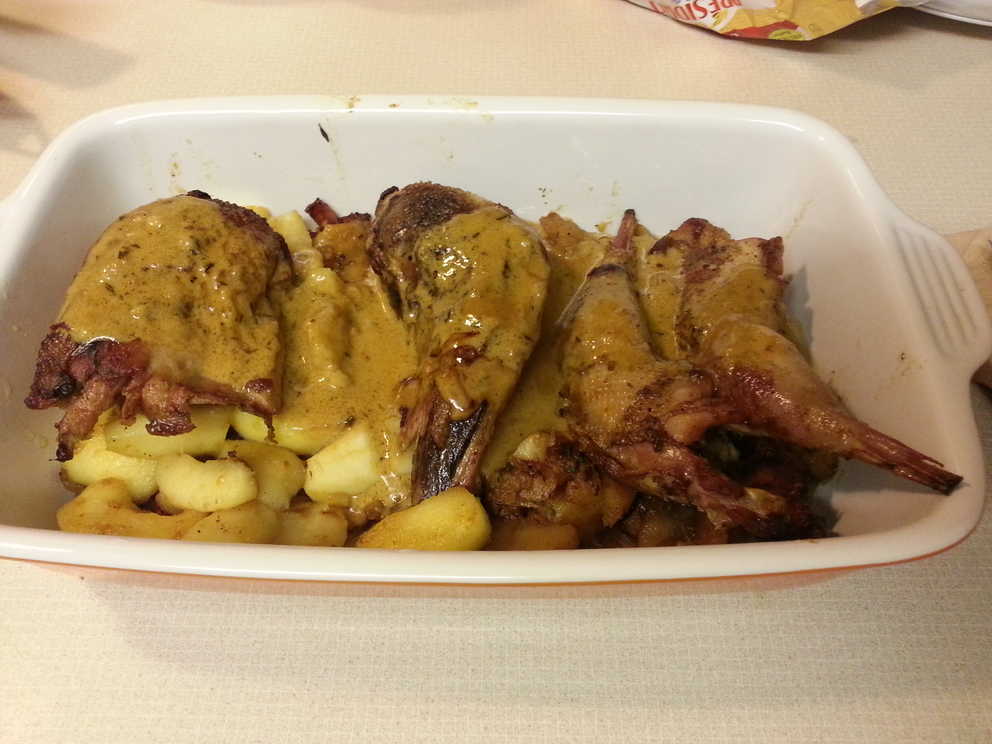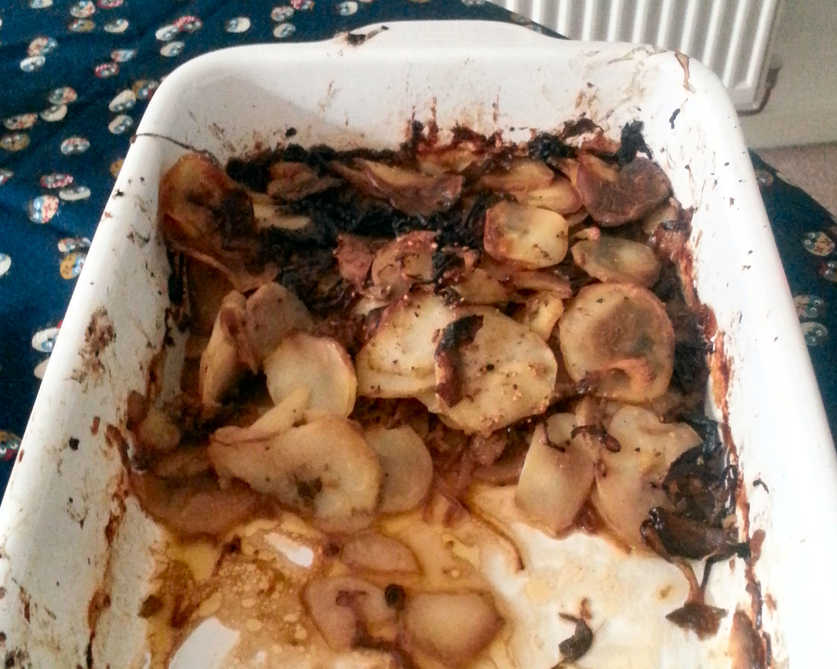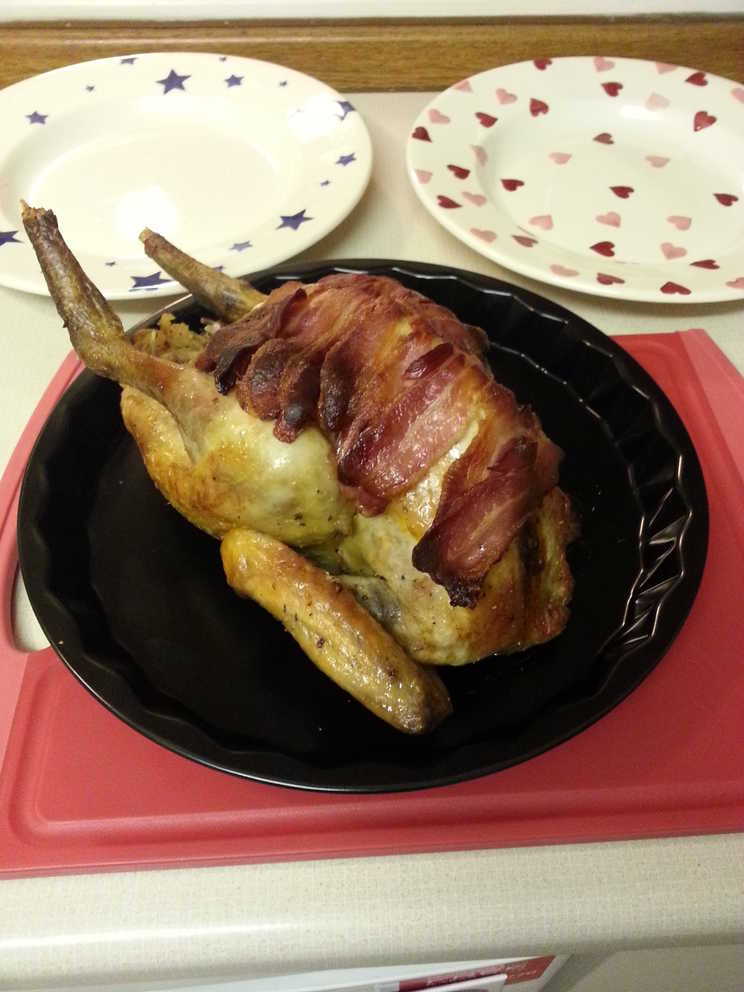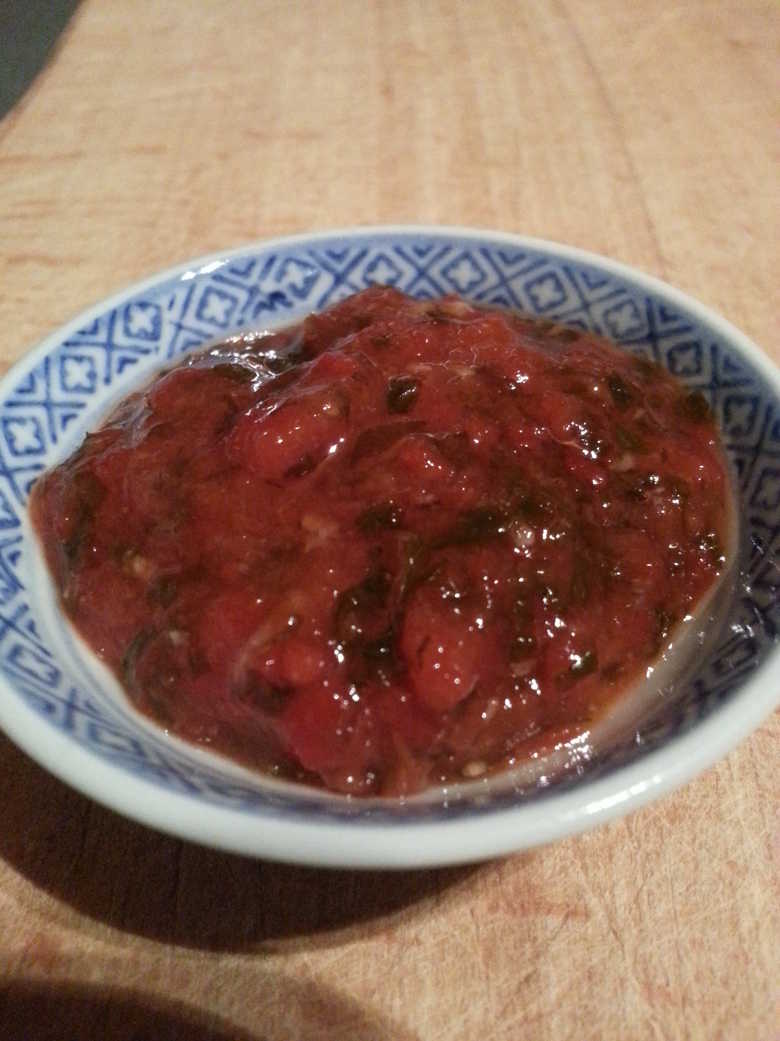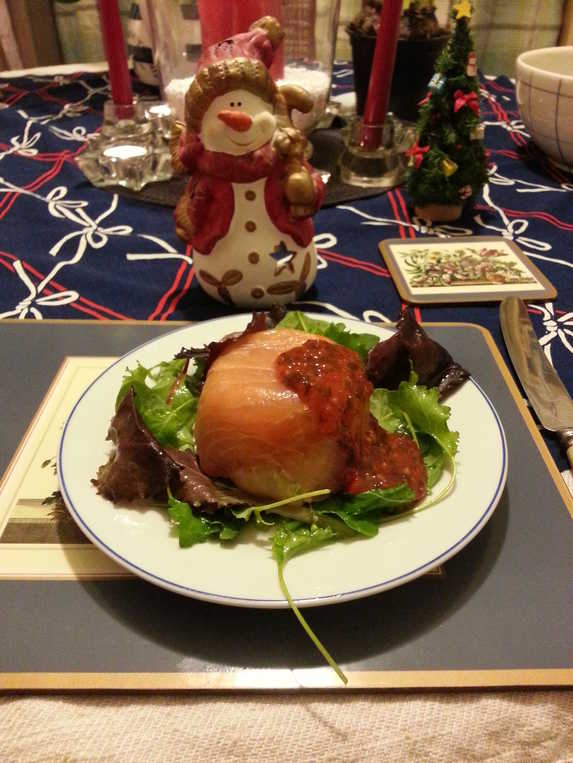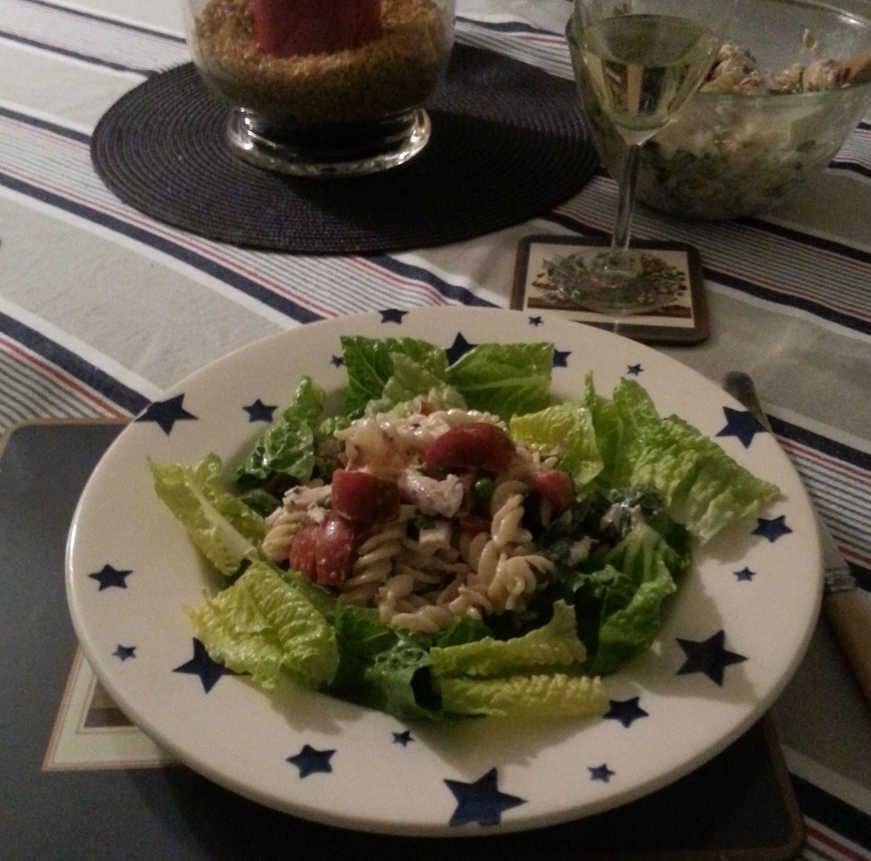
A Pleasant Pheasant, Flora's Foody Fancies and a Crack at Christmas

Cooking is a bit like sex. Everyone thinks they can do it, but most people are just crap at it.
On an unrelated note Flora has come up with some ideas for food she fancies having. And possibly having me cook. It seems to involve a lot of fruit:
Flora's Fun Foody Fancies
- Starter:
- Main:
- Fruit Curry - choose from mango/pineapple/lychee/coconut
- papayas
- wild rice
- Dessert:
- Cucumber & Mint Sorbet
- Whisky (Talisker?) Ice Cream
- Avocado & Chocolate Ice Cream HEY - that's my idea
- Toast (Brioche?) and Marmalade Ice Cream
- Popcorn Ice Cream
- Hazel Nut Ice Cream
- Aidan's Nutty Ice Creams whatever they are :)
Regularly :O
Flora dressed her own farfalle salad while I gave her pheasant a pleasant seeing to.
A damn fine job we made of the pheasant too. We're teetotal at the moment, but figured a saucy cider wouldn't be breaking the pledge. Somewhere amongst the meals we shoved in some French baker's potatoes too, though I can't now remember what we ate them with. After a while all these meals start to run together...
Our latest dinner was perfectly memorable, though: an exploratory Xmas for both of us - I tried this year's seasonal starter and a novelty stuffing and Flora had a run through of her whole Guinea-Fowl-based Christmas dinner. I laid the wee bird on a bed of chopped onion, carrots and celery, stuffed her cavity with my spuds, and roast her at 160°C for about 1½ hours, maybe longer (which might explain the over-roasties), until the stuffing came up to safe eating temperature (70°C).
I also tried making a baked fruit compote, covered with foil in the bottom of the oven - using grapefruit, lemon and apple slices leftover from my Christmas baking, plus a dash of port, red wine, Cointreau and some sugar syrup left over from my candied peel. You know, for making my mincemeat. For my mince pies.
Flora tried it next day after I'd remembered about it and reported that it tasted burnt :(
The things we both learned:
- Stock takes a good 10 minutes to defrost in the microwave.
- Even with two ovens it's possible to overcook the roasties. I blame the oven. And the old, small, waxy potatoes. And the uncertain cooking time for the bird. Allegedly if you need to pull the roasties out early to keep warm you can get them crispy again by putting them back in a hot oven. But don't cover them with foil or they'll turn soggy. Suffice to say I didn't try it.
- Oven-cooked Bread Sauce takes longer than the time necessary to cook a Guinea fowl, and is better made with a quality bread product.
- Left-over red wine makes for a lovely gravy.
- It's possible to add too much orange flavouring to the stuffing.
- There may not be room for pudding!
On the BIG DAY™.
Coming soon!
Braised Pheasant with Cider and Apples and Celeriac
main fowl
A very pleasant pheasant indeed.
I improved Blanch Vaughan's dish slightly by adding some root vegetables, and reducing the liquid a bit harder so the pheasant braises above the liquid rather than boils in it.
This dish goes so well with celeriac mash that I included it in the recipe. Obviously you don't have to.
I improved Blanch Vaughan's dish slightly by adding some root vegetables, and reducing the liquid a bit harder so the pheasant braises above the liquid rather than boils in it.
This dish goes so well with celeriac mash that I included it in the recipe. Obviously you don't have to.
Serves 2
Ingredients
- 1 pheasant
- olive oil
- butter
- 8 small onions or shallots, peeled, whole
- 500ml dry cider
- 1 small celeriac, peeled
- 1 parsnip, peeled, sliced
- bunch thyme, leaves only, roughly chopped
- 100g smoked bacon lardons, or sliced thick rashers
- chicken stock
- 6 juniper berries, crushed
- 2 potatoes
- 2 apples, peeled, cored, sliced
- juice of 1 lemon
Preheat the oven to 175°C/350°F/Gas Mark 4.
Prick the potatoes and put on the top shelf of the oven to bake for mashing.
Peel the small onions quarter or halve any large ones, but leave them connected at the root and add to the casserole with slices of thick smoked bacon, or lardons. Stir to coat until they start to colour.
Peel the parsnip and slice into ½" rounds. Peel the celeriac, cut into quarters, cut a half-dozen ½" slices and set the rest aside. Add the parsnip and celeriac slices to the casserole with a half-dozen crushed juniper berries and stir until nicely buttered and taking on a little colour.
Remove the parsnip, then add the cider and stock and bubble off over high heat until enough is left to just cover the vegetables (about ½-1"). Throw in chopped thyme leaves, return the parsnips to the casserole then lay the pheasant pieces on top. The liquid should just reach them.
Cover tightly use a piece of tin foil under the lid for a good seal and cook in a Gas 4 oven for up to an hour until the pheasant is tender.
Peel the apples, core, and cut into fat slices or peel, slice then core, dress with lemon juice to prevent browning and set aside until needed.
Cut the rest of the celeriac into large chunks and set to simmer or steam until (very) tender; about 20 minutes. Mash or purée enthusiastically (it can be a bit lumpy) then scoop out the baked potato and add that in together with a generous amount of butter and spoonful or two of the crème fraîche.
Season and keep warm.
Warm a serving dish for the pheasant.
Heat some butter in a frying pan until foaming and put in the apple pieces in a single layer turning once until nicely browned all over. Resist moving them too much to avoid them breaking up.
Take the casserole out of the oven and remove the pheasant pieces to rest a few minutes. Scoop the vegetables and bacon out and layer in the serving dish along with the cooked apple. Place the pheasant pieces on top.
Reduce the sauce left in the casserole dish, if required, then whisk in a tablespoon or two of crème fraîche or to taste over a low heat. The sauce should thicken a little and be light brown coloured - don't allow it to boil hard lest it curdle.
Pour the sauce over the pheasant dish and serve with celeriac mash.
Prick the potatoes and put on the top shelf of the oven to bake for mashing.
If you have two ovens you should bake the potatoes at 200°C/400°F/Gas Mark 6 so they're ready in time!
Joint the pheasant into two legs and two breasts with wings attached. Leave them all on the bone.
Have a good feel for lead shot, any bits of feather or bone and season well with salt & pepper.
Heat a mixture of olive oil and butter in a heavy casserole until foaming and brown the pheasant all over. Set aside.Peel the small onions quarter or halve any large ones, but leave them connected at the root and add to the casserole with slices of thick smoked bacon, or lardons. Stir to coat until they start to colour.
Peel the parsnip and slice into ½" rounds. Peel the celeriac, cut into quarters, cut a half-dozen ½" slices and set the rest aside. Add the parsnip and celeriac slices to the casserole with a half-dozen crushed juniper berries and stir until nicely buttered and taking on a little colour.
Remove the parsnip, then add the cider and stock and bubble off over high heat until enough is left to just cover the vegetables (about ½-1"). Throw in chopped thyme leaves, return the parsnips to the casserole then lay the pheasant pieces on top. The liquid should just reach them.
Cover tightly use a piece of tin foil under the lid for a good seal and cook in a Gas 4 oven for up to an hour until the pheasant is tender.
You can remove the breasts earlier and set aside if they cook quicker than the legs.
Peel the apples, core, and cut into fat slices or peel, slice then core, dress with lemon juice to prevent browning and set aside until needed.
Cut the rest of the celeriac into large chunks and set to simmer or steam until (very) tender; about 20 minutes. Mash or purée enthusiastically (it can be a bit lumpy) then scoop out the baked potato and add that in together with a generous amount of butter and spoonful or two of the crème fraîche.
Season and keep warm.
Warm a serving dish for the pheasant.
Heat some butter in a frying pan until foaming and put in the apple pieces in a single layer turning once until nicely browned all over. Resist moving them too much to avoid them breaking up.
Take the casserole out of the oven and remove the pheasant pieces to rest a few minutes. Scoop the vegetables and bacon out and layer in the serving dish along with the cooked apple. Place the pheasant pieces on top.
Reduce the sauce left in the casserole dish, if required, then whisk in a tablespoon or two of crème fraîche or to taste over a low heat. The sauce should thicken a little and be light brown coloured - don't allow it to boil hard lest it curdle.
Pour the sauce over the pheasant dish and serve with celeriac mash.
Most excellent.
Potatoes Boulangère
Baked potato casserole
veg side
In Lyon, potatoes are pan-fried or baked with onions in a relatively shallow layer and served dressed with parsley.
Which is OK, but a bit dry.
Down at the boulangerie the potatoes are cooked slowly in stock in the baker's oven. Which gives the dish a huge flavour boost, plus you can pile the casserole much deeper - something more approaching a gratin dauphinoise.
Beef or chicken stock is good, though you can use vegetable stock for a vegetarian version.
For some reason I par-boiled my potato slices before baking them - you probably don't need to. Also most people don't caramelize, or even cook, their onions first. But the result is very luscious.
Which is OK, but a bit dry.
Down at the boulangerie the potatoes are cooked slowly in stock in the baker's oven. Which gives the dish a huge flavour boost, plus you can pile the casserole much deeper - something more approaching a gratin dauphinoise.
Beef or chicken stock is good, though you can use vegetable stock for a vegetarian version.
For some reason I par-boiled my potato slices before baking them - you probably don't need to. Also most people don't caramelize, or even cook, their onions first. But the result is very luscious.
Serves 4-6
Ingredients
- 2lb (waxy) potatoes, sliced
- 4 onions, sliced
- 6 garlic cloves
- butter
- seasoning
- about 1 pint stock
- white wine for deglazing optional
Preheat the oven to 180°C/350°F/Gas Mark 4.
Slice potatoes about ¼" then simmer for 5-10 minutes until just cooked and changing colour, but still firm. Drain, cool and set aside. Or don't bother? Slice the onions thinly and fry them gently in butter until nicely and evenly caramelized. Deglaze with white wine if you have some. Set aside.
Press, purée or thinly slice the garlic.
Melt a knob of butter in a casserole dish, line it with a third of the potatoes, then cover with half the onions, half the garlic and season the layer.
Add the next third of potatoes, dot with butter, then cover with the remaining onions and garlic and season.
Finally cover with the remaining potatoes, dot with more butter and pour in the stock almost to cover. But not quite - you don't want it swimming in liquid. Put the casserole in the top of the oven for up to an hour until golden on top and easily penetrated with a knife. Cover as necessary to stop it burning.
Slice potatoes about ¼" then simmer for 5-10 minutes until just cooked and changing colour, but still firm. Drain, cool and set aside. Or don't bother? Slice the onions thinly and fry them gently in butter until nicely and evenly caramelized. Deglaze with white wine if you have some. Set aside.
Press, purée or thinly slice the garlic.
Melt a knob of butter in a casserole dish, line it with a third of the potatoes, then cover with half the onions, half the garlic and season the layer.
Add the next third of potatoes, dot with butter, then cover with the remaining onions and garlic and season.
Finally cover with the remaining potatoes, dot with more butter and pour in the stock almost to cover. But not quite - you don't want it swimming in liquid. Put the casserole in the top of the oven for up to an hour until golden on top and easily penetrated with a knife. Cover as necessary to stop it burning.
Very tasty.
You could add herbs (rosemary, thyme) if you liked or serve it dressed with parsley.
You could add herbs (rosemary, thyme) if you liked or serve it dressed with parsley.
Honey-Mustard Chicken Pasta
Pasta salad
fowl salad starter pasta
Flora made a good fist of this salad with a bit of my assistance, and a long-running chicken which she had sitting around for too long.
She added in some frozen peas, and Mozzarella (which was a good idea). The rest is all the BBC's.
She added in some frozen peas, and Mozzarella (which was a good idea). The rest is all the BBC's.
Serves 4
Ingredients
- 300g farfalle or other pasta shape
- 3 tbsp reduced-fat mayonnaise (use full-fat if you prefer) yes, I prefer
- 1 heaped tsp wholegrain mustard
- 1 tsp clear honey
- 300g cooked chicken, torn into rough pieces
- 4 spring onions, thinly sliced (or use red onion, thinly sliced)
- cooked peas
- small bunch basil, leaves roughly torn
- 4 tomatoes, quartered, then each chunk halved
- 1 large-ish Mozzarella
Boil the pasta, then cool under running water.
Mix the mayo, mustard and honey in a large bowl and loosen with a little water to make a dressing the consistency of double cream.
Add the pasta, chicken, onions, peas, and basil, season to taste, then gently mix together with the tomatoes and pieces of Mozzarella
Mix the mayo, mustard and honey in a large bowl and loosen with a little water to make a dressing the consistency of double cream.
Add the pasta, chicken, onions, peas, and basil, season to taste, then gently mix together with the tomatoes and pieces of Mozzarella
Flora's comment:
Karl and I added most of ¾ of a large Mozzarella. I put red onion in instead of spring onions. My bunch of basil was several stalks of a basil plant. Karl thought it was going to be too much but actually turned out OK. We used fusilloni pasta as there wasn't any farfalle. Needed a bigger bowl and top with parmigiano or pesto really? - Ed or both.
We though it tasted very yummy and would do again! We also had peas in the salad.
Karl and I added most of ¾ of a large Mozzarella. I put red onion in instead of spring onions. My bunch of basil was several stalks of a basil plant. Karl thought it was going to be too much but actually turned out OK. We used fusilloni pasta as there wasn't any farfalle. Needed a bigger bowl and top with parmigiano or pesto really? - Ed or both.
We though it tasted very yummy and would do again! We also had peas in the salad.
Roast Guinea Fowl
fowl main
A pretty convenient way of serving a small roast bird. You also get some tasty veg out of it for free!
Serves 2
Ingredients
- 1-3 onions, cut into wedges, through the root
- 2-3 carrots, quartered lengthways
- 2-3 sticks celery
- 1 tbsp olive oil
- 1 small guinea fowl (around 1kg/2lb 4oz)
- 1 tbsp butter at room temperature, plus 2 tsp for the gravy
- smoked streaky bacon rashers
- 6 garlic cloves, unpeeled
- few thyme sprigs
- 300ml chicken stock
- 100ml white wine
- 2 tsp plain flour
- 1 tbsp redcurrant jelly or left-over red wine
Heat oven to 180C/160C fan/gas 4 or slightly lower if you're stuffing the bird so it doesn't dry out before the stuffing cooks.
Chop the vegetables I replaced the original large potato with celery since we're having plenty of roast potatoes,
toss them with the oil and some seasoning in a large flameproof roasting tin.
Season the bird generously inside and out, stuff it if you're going there, then smear with a tablespoon or two of soft butter and lay the rashers in a row (or a cross!) over the breast.
Place on top of the vegetables, and put in to roast for 40 minutes.
Remove from the oven and give the veg a stir while adding the garlic and thyme. Pour 200ml stock and the wine or enough to moisten without drowning over the veg and return to oven to roast for another 40 mins until the bird is cooked through and the juices run clear.
Remove the veg with a slotted spoon and transfer to the serving plate with the bird. Mix 2 tsp butter and flour in a small bowl to form a smooth paste. Place the roasting tin with all the cooking juices, plus any resting juices, on the hob. Whisk the paste and redcurrant jelly into the juices until dissolved, then add the remaining stock and extra seasoning, if you like. Bubble for a few mins until the sauce thickens. Slice and serve the guinea fowl, crisp bacon and the veg with the sauce on the side.
Remove from the oven and give the veg a stir while adding the garlic and thyme. Pour 200ml stock and the wine or enough to moisten without drowning over the veg and return to oven to roast for another 40 mins until the bird is cooked through and the juices run clear.
You'll need to keep a bit of an eye on it to make sure it doesn't darken or dry out - cover with tin foil if it starts to look a bit crispy.
My bird took 10 or 20 minutes longer to cook the stuffing, at about Gas 3.
Remove the bird, place on a serving plate, cover with foil to keep warm and leave to rest.
Turn the oven up to 200C/180C fan/gas 6 and roast the veg for a further 15 mins until tender pour off any excess stock first.My bird took 10 or 20 minutes longer to cook the stuffing, at about Gas 3.
Remove the veg with a slotted spoon and transfer to the serving plate with the bird. Mix 2 tsp butter and flour in a small bowl to form a smooth paste. Place the roasting tin with all the cooking juices, plus any resting juices, on the hob. Whisk the paste and redcurrant jelly into the juices until dissolved, then add the remaining stock and extra seasoning, if you like. Bubble for a few mins until the sauce thickens. Slice and serve the guinea fowl, crisp bacon and the veg with the sauce on the side.
Excellent - the veg are especially nice too (as long as you cook them at a high temperature long enough for the carrots to soften and the onions to begin caramelising).
I made a more traditional gravy by frying a roux of 2-3 tablespoons flour with the same volume of butter in a saucepan to brown, adding red wine, then the cooking and resting juices, plus some extra defrosted stock.
I made a more traditional gravy by frying a roux of 2-3 tablespoons flour with the same volume of butter in a saucepan to brown, adding red wine, then the cooking and resting juices, plus some extra defrosted stock.
PERFECT Stuffing for Christmas Goose
ingredient side meat
To bread, or not to bread?
I thought I might try a different kind of stuffing for this year's goose - using potato rather than bread. Though I haven't decided whether or not to add some bread anyway (no). All the recipes I found mash the spuds, which wasn't my original intention, but perhaps it makes sense. I decided to completely forgo onion and celery, and substitute leeks instead.
A word on stuffing poultry:
The point of stuffing the guts of your giant air-cow is both to moisten the beast from the inside (particularly if you've gone for one of those turkey things which have the texture of wicker), and to soak up lots of lovely flavour juices in the process. The disadvantage being that you can overcook the flesh while you wait for the stuffing to reach safe temperatures.
An ideal solution is to scoop the stuffing into a baking dish to finish in the oven while the bird rests, that way you get all the flavour of the inside stuffing, with the salmonella-safe crispy finish of the dressing version.
Personally I stuff my bird 'cos it's the family tradition and there's no room in the oven for another dish.
Unfortunately like everything else in life the nannyists have something to say about the way you stuff your Christmas bird. Surprise surprise they're agin' it!
It is, I suppose, entirely possible that shoving warm stuffing into a cold salmonella-riddled fowl, leaving it to breed overnight in a nice warm kitchen, then meticulously under-cooking the ensemble so the juices run red with viscous blood, could reasonably result in a good dose of food poisoning. Especially if you throw some bacteria-packed eggs into the mix.
Thing is, it's never happened to me*.
It's never happened to my family, who've been happily stuffing their Christmas bird for generations.
Outside of a commercial setting, I've never heard of it happening.
I've never met anyone to whom it happened.
I've never met anyone who's heard of it happening.
So if I were you I'd take some reasonable precautions like letting the stuffing go cold before mixing it and stuffing the bird, and using a thermometer to make sure your stuffing cooks to 70°C/165°F and just tell those bird-bothers to fuck off.
* At least, not without ramming the chicken into a pumpkin first.
I thought I might try a different kind of stuffing for this year's goose - using potato rather than bread. Though I haven't decided whether or not to add some bread anyway (no). All the recipes I found mash the spuds, which wasn't my original intention, but perhaps it makes sense. I decided to completely forgo onion and celery, and substitute leeks instead.
A word on stuffing poultry:
The point of stuffing the guts of your giant air-cow is both to moisten the beast from the inside (particularly if you've gone for one of those turkey things which have the texture of wicker), and to soak up lots of lovely flavour juices in the process. The disadvantage being that you can overcook the flesh while you wait for the stuffing to reach safe temperatures.
An ideal solution is to scoop the stuffing into a baking dish to finish in the oven while the bird rests, that way you get all the flavour of the inside stuffing, with the salmonella-safe crispy finish of the dressing version.
Personally I stuff my bird 'cos it's the family tradition and there's no room in the oven for another dish.
Unfortunately like everything else in life the nannyists have something to say about the way you stuff your Christmas bird. Surprise surprise they're agin' it!
It is, I suppose, entirely possible that shoving warm stuffing into a cold salmonella-riddled fowl, leaving it to breed overnight in a nice warm kitchen, then meticulously under-cooking the ensemble so the juices run red with viscous blood, could reasonably result in a good dose of food poisoning. Especially if you throw some bacteria-packed eggs into the mix.
Thing is, it's never happened to me*.
It's never happened to my family, who've been happily stuffing their Christmas bird for generations.
Outside of a commercial setting, I've never heard of it happening.
I've never met anyone to whom it happened.
I've never met anyone who's heard of it happening.
So if I were you I'd take some reasonable precautions like letting the stuffing go cold before mixing it and stuffing the bird, and using a thermometer to make sure your stuffing cooks to 70°C/165°F and just tell those bird-bothers to fuck off.
* At least, not without ramming the chicken into a pumpkin first.
Fills a goose
Ingredients
- 1kg potatoes, baked, mashed
- 400g fatty bacon, chopped preferably not smoked, which can be too salty
- 2-3 leeks
- 1 large firm apple Bramley or Granny Smith and no more!
- 1 head garlic
- juice and peel of 1 orange you may not want all the any peel
- Grand Marnier or Cointreau
- thyme
- parsley
- sage
Put the potatoes in the oven to bake. Add a head of garlic half-way through (don't overcook it).
Heat some butter in a frying pan and fry the bacon until starting to crisp and scoop into a bowl.
Slice leeks into rounds, wash carefully, then add to the frying pan and cook until browning at the edges. Some of the thinner strands may turn crispy. Add to the bowl.
Core and peel the apple, chop roughly and add to the frying pan, and fry to colour a little. Deglaze with the Grand Marnier if using, then add the orange juice and reduce until the apple is soft and the juice reduced (scoop out the apple early if it starts to disintegrate). Add to the bowl.
Mash the potato roughly and add to the bowl with the squeezed roast garlic cloves, and herbs.
Mix gently.
Allow to cool completely.
Stuff bird.
Heat some butter in a frying pan and fry the bacon until starting to crisp and scoop into a bowl.
Slice leeks into rounds, wash carefully, then add to the frying pan and cook until browning at the edges. Some of the thinner strands may turn crispy. Add to the bowl.
Core and peel the apple, chop roughly and add to the frying pan, and fry to colour a little. Deglaze with the Grand Marnier if using, then add the orange juice and reduce until the apple is soft and the juice reduced (scoop out the apple early if it starts to disintegrate). Add to the bowl.
Mash the potato roughly and add to the bowl with the squeezed roast garlic cloves, and herbs.
Mix gently.
Allow to cool completely.
Stuff bird.
Adjust the amount of herbs and orange peel as required. Don't overload with any particular flavour.
I made a half-quantity with all the juice of one orange and about a quarter of the peel, and the orange flavour was overwhelming.
Should have skipped the peel entirely and gone a bit easy on the Cointreau!
I was prepared to add some breadcrumbs if the recipe seemed to need it, but actually it was perfectly good as it was.
I was prepared to add some breadcrumbs if the recipe seemed to need it, but actually it was perfectly good as it was.
Season the stuffing lightly if you like, but taste it first - some bacon can be very salty.
Sweet Chilli Sauce
sauce
A mild sauce, though you can replace the bell pepper with chillies if you want to crank up the heat.
A more traditional Thai sauce might also have a little fish sauce and would not be thickened with starch, but cooked down until syrupy after blending.
A more traditional Thai sauce might also have a little fish sauce and would not be thickened with starch, but cooked down until syrupy after blending.
Makes about 200ml
Ingredients
- 1 red bell pepper or other sweet pepper, seeded, chopped
- 3 garlic cloves, crushed
- 2 hot fresh red chillies, chopped or to taste
- 100ml sugar or more to taste
- 100ml water
- 100ml rice vinegar
- ginger, grated optional
- lime zest and juice optional
- 1 tablespoon cornflour
- coriander, minced optional
Seed and chop the pepper and chillies (you can leave in the chilli seeds if you want more heat),
crush the garlic, grate the ginger and lime zest if using, and add to a pan with the water, sugar and vinegar.
Simmer rapidly for 10 minutes, then reduce to a low bubble.
Add the lime juice if using and return to the boil. Mix the cornflour with a little cold water and add to the pan.
Stir until it thickens.
crush the garlic, grate the ginger and lime zest if using, and add to a pan with the water, sugar and vinegar.
Simmer rapidly for 10 minutes, then reduce to a low bubble.
Add the lime juice if using and return to the boil. Mix the cornflour with a little cold water and add to the pan.
Stir until it thickens.
Don't add all the cornflour mixture at once until you see how thick it becomes.
If you prefer, you can skip the cornflour and after blending just simmer until it reduces and thickens naturally - perhaps 30 minutes.
You might need to use more sugar.
Allow to cool a little then pulse a few times in a food processor until you like the consistency (you're not trying for paste).If you prefer, you can skip the cornflour and after blending just simmer until it reduces and thickens naturally - perhaps 30 minutes.
You might need to use more sugar.
If you're adding coriander, separate the leaves, wash and blanch them, chop them finely and add them to the sauce when its cooled.
Will keep in the fridge for weeks.
I think the coriander adds a nice fresh tang, but it does turn an unsightly black colour if you cook it in the sauce so here we add it at the end.
Blanching it removes the risk of bacterial buildup, though if you're using the sauce immediately that won't matter.
Also it doesn't chop up in the processor, so make sure it's minced, not merely sliced.
Also it doesn't chop up in the processor, so make sure it's minced, not merely sliced.
Smoked Salmon and Avocado Terrines
starter fish cheese
A fairly easy and tasty starter,
even if Sara doesn't seem too clear on the fact that
Chèvre is just French for goat's cheese.
It won't keep too long in the fridge though - a couple of days, tops. The quantity will make 6 large terrines, perhaps ungainly large - to stretch it to 8 you'll have to avoid overfilling.
Quite thin smoked salmon will be helpful.
It won't keep too long in the fridge though - a couple of days, tops. The quantity will make 6 large terrines, perhaps ungainly large - to stretch it to 8 you'll have to avoid overfilling.
Quite thin smoked salmon will be helpful.
Serves 6-8
Ingredients
- sunflower oil, for greasing
- 300g and 150g pack thinly sliced smoked salmon
- 75g Chevre or other mild goat's cheese [sic!], broken into small pieces
- 75g very soft mild goat's cheese or to taste
- 3 tbsp snipped chives
- 3 large ripe avocado, peeled, stoned and finely chopped
- 3 tbsp lemon juice
- sweet chilli sauce, for drizzling
To Serve:- salad leaves and vinaigrette
Lightly oil 8 small ramekins. Line with cling film, then the salmon (either 1 large or 2 smaller slices), allowing plenty of overhang.
Gently mix together the cheese, chives and avocado with the lemon juice and plenty of seasoning. Spoon into the salmon-lined ramekins, press down, fold over the overlapping salmon, then cling film to seal in the mixture. Can be made the night before, but if making on the day they should be chilled for at least 4 hrs.
On the day, gently lift the terrines out of the ramekins using the cling film, then remove the film. Place the terrines on plates with some baby salad leaves tossed in a little vinaigrette. Drizzle the terrine and plate with sweet chilli sauce.
Serve on their own or with toast.
Gently mix together the cheese, chives and avocado with the lemon juice and plenty of seasoning. Spoon into the salmon-lined ramekins, press down, fold over the overlapping salmon, then cling film to seal in the mixture. Can be made the night before, but if making on the day they should be chilled for at least 4 hrs.
On the day, gently lift the terrines out of the ramekins using the cling film, then remove the film. Place the terrines on plates with some baby salad leaves tossed in a little vinaigrette. Drizzle the terrine and plate with sweet chilli sauce.
Serve on their own or with toast.
I used a combination of firm and soft goats cheeses (or Chèvres) as above, probably more than the original recipe's 100g.
Mix in as much of the softer cheese as you like for consistency and taste.
I did try finely shredded spring onions instead of the chives, but thought the chives a marginal improvement.
Quality smoked salmon is key - though the Local Fucking Supermarket™ versions I tried were a thinner cut, my fishmonger's own-smoked variety couldn't be beat for full, rich flavour.
I did try finely shredded spring onions instead of the chives, but thought the chives a marginal improvement.
Quality smoked salmon is key - though the Local Fucking Supermarket™ versions I tried were a thinner cut, my fishmonger's own-smoked variety couldn't be beat for full, rich flavour.
